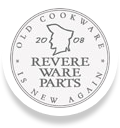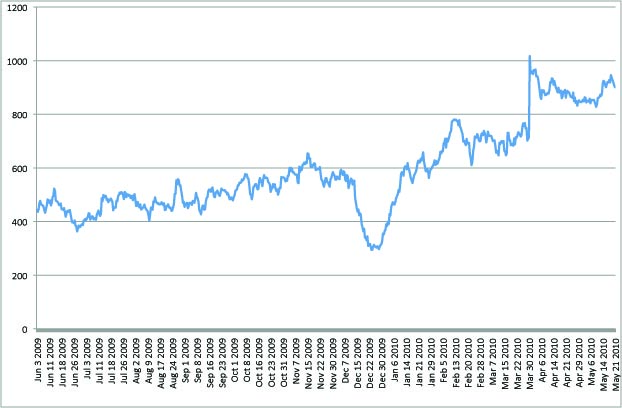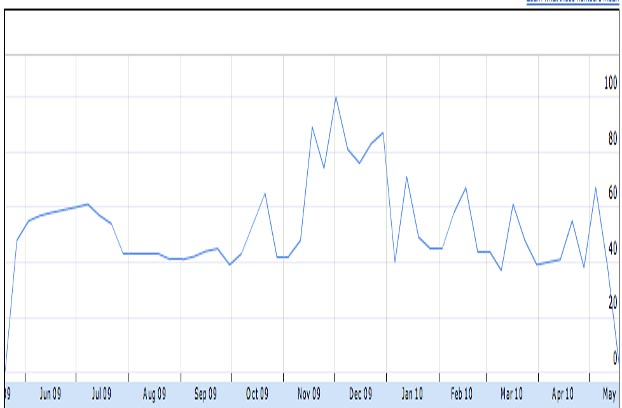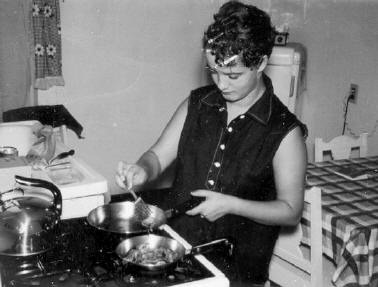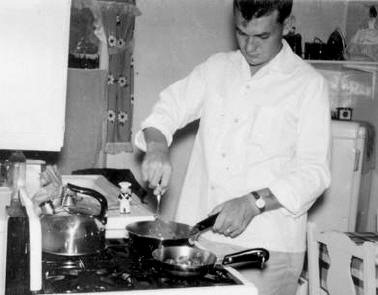I have no idea what this strange Revere sign for sale on Ebay actually is.
Author Archive | RevereWareParts
World Kitchen building sold
On a slow news day, I guess this story makes sense. World Kitchen, the owners of the Revere Ware brand (among others, including Pyrex, CorningWare, and EKCO) just signed a new 10 year lease on their building in Chicago. The building was recently sold to a group of REIT investors.
Metal in the microwave
My recent purchase of a Revere Ware micro fryer got me thinking about the taboo of putting metal in the microwave. If you believe the micro-fryer literature, microwaving food in metal cookware is superior to either microwaving in non-metal or cooking in metal on the stove.
So I did a little research. Most microwave ovens include a warning about using metal in the microwave. But I did find one interesting article entitled You Can Use Metal in a Microwave Oven, which appears to be a very thorough and well-researched investigation into microwaves and metal cookware.
What exactly are the benefits of cooking in a microwave oven?
- Faster cooking that uses less power. (Hey, its GREEN!)
- What you are cooking won’t brown on top until it is fully cooked. Ever tried cooking a frozen dish that turns out burned on top but frozen in the middle?
- Using metal in the microwave, food can be more evenly heated, avoiding those molten-outside frozen inside results.
- Metal won’t break, melt, or burn, and won’t leach nasty BPA (like some plastics) into your food.
- You can use the same cookware to cook a dish both on the stove AND the microwave, for perfect results.
The most important thing about cooking in the microwave with metal cookware is to use microwave safe metal dishes. What makes cookware unsafe for the microwave are:
- Microwaves can cause an electric arc to appear between two improperly placed pieces of metal. The user’s ability, to cause an arc, or prevent an arc, depends on the size and shape, of the metal pieces, their relationship to each other, and the lossiness of the load in the oven cavity.
- A metal utensil will arc to the oven walls, depending on its size, shape, distance from the oven walls, and the amount of food or other lossy material in the oven cavity.
- Metal reflects microwaves. A metal pot with a metal cover shields the food, that it contains, from microwave energy. Food, in a metal pot with a metal cover, will not get hot. The dimensions of the metal container in relationship to the size of the food is also important.
- The black, phenolic handles on metal pots and pans are not “Microwave Safe.” Phenolic is a plastic material, that has been used since the early part of this century as handles for metal pots and pans. Phenolic handles explode when exposed to microwaves.
Ok, so no utensils, no pots with long handles, and no phenolic handles. I had a little trouble determining exactly what a phenolic handle is and whether Bakelite fits into this category. My micro-fryer does have what appears to be a Bakelite handle, but it may be a different formulation that is particularly microwave safe. Let’s just say no Bakelite handles in the microwave unless the instructions specifically say it is microwave safe.
The bottom suggestion by the article is to stick with cookware that is specifically designed for microwave cooking. Given that not much metal cookware for the microwave is sold these days (if any at all), this might be difficult. The value of my micro fryer just went up.
New vintage Revere Ware pressure cooker booklet
With manuals in hand, I thought I knew all there was about the vintage 4 quart Revere Ware pressure cookers, but I just came across a pamphlet that was distributed with the pressure cookers entitles Know Your Revere Pressure Cooker, and it has some interesting information and clearly shows how the Revere pressure cooker was superior to others when it was introduced.
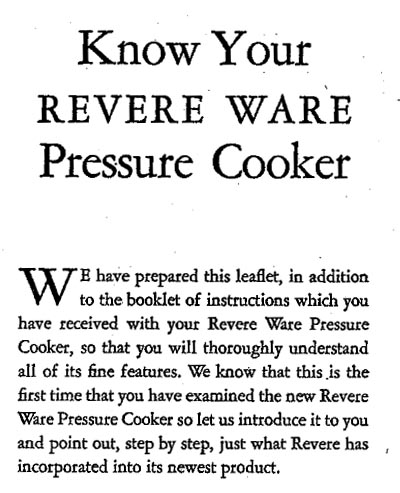
Among the tips gleaned from this pamphlet:
- The sealed pressure gauge is completely waterproof so you don’t have to worry about fully immersing the lid in water.
- The grooves in the underside of the vent hole are there to keep the hole from clogging up easily should food get pressed against it.
- Instructions for removing the gauge.
- A better description of the over-pressure plug.
- Instructions for dealing with a too-tight fitting gasket.
- The cover twists to remove to the right or left, benefiting both right and left-handed cooks.
Bakelite dishwasher test
Previously, when figuring out whether Bakelite was dishwasher safe or not, I had to rely on my own anecdotal evidence, far from scientific. Finding that less than satisfying, I decided to perform my own test to see just how well Bakelite held up in the dishwasher.
The test was simple; I attached two Bakelite handle halves to the dishwasher rack with zip ties, one on the top rack, and one on the bottom. In our household, we do about a load of dishes each day, so it is safe to say that the number of washes is about equal to the number of days in the dishwasher, within a few percent.
After two months, or 60 washes, I began to notice a little bit of fading and dulling of the shine on the Bakelite. Below is what the handles look like after six months, or 180 washes. The darker/shinier handle is the unwashed (new) comparison.
Clearly, the Bakelite has suffered as a result of washing in the dishwasher. There was no difference between the top rack and bottom rack; both suffered equally.
I can now say with great confidence that you should refrain from putting your cookware with Bakelite parts into the dishwasher.
More and more Revere Ware on Ebay
With almost one years worth of data on the total number of Revere Ware items for sale on Ebay every day, the total volume continues to go up.
In contrast, the volume of Google searches for the keyword “revere ware” is fairly flat (except a spike over the holidays) over the same period of time.
I presently have no theory on why the volume on Ebay continues to go up, almost doubling from a year ago.
Making homemade yogurt with your Revere Ware pots
I often tell people that we make our own yogurt, which makes my wife laugh, because it would be more accurate to say that she makes yogurt. Homemade yogurt is easy, fresh, very tasty, and inexpensive and there are lots of different ways to make it. We (my wife) started by making it in the oven but when we moved we discovered that most ovens won’t hold a steady enough low temperature to make yogurt. We now use a yogurt maker. My grandmother in Europe used to make yogurt by having seven plastic tubs on the window sill (one for each day of the week). Each day they would take one down and put a new one up. It took seven days for the yogurt to fully develop in the sun.
So, you can imagine I found it interesting when I came upon this recipe for making yogurt that involved using Revere Ware pots.
Revere Ware and Teflon
I came across this page recently that includes a published warning by Revere Ware of the dangers of fumes released by Teflon coated pans that are heated without contents and the danger they post to pet birds. Teflon coated Revere Ware pans have not been on our list of preferred vintage Revere Ware but we thought this tip was worth passing on.
Update: the original warning that mentioned Revere Ware specifically has been removed from the Environmental Working Groups website. Here is their general Teflon warning.
Revere Ware and memories
Revere Ware is useful stuff that still has a place in a modern kitchen. But given that Revere Ware cookware can last a long time, it also comes with a rich history. Hardly a week goes by that I don’t receive comments (and thanks) along with orders about how someone is buying parts for the Revere Ware they received on their wedding in 1947 or was handed down to them from their parents. In fact, I was very glad to replace the Bakelite parts on my 80-year-old mother-in-law’s Revere Ware.
So it is great to find the occasional pictures of people using their Revere Ware when they first got it, like these from a couple in 1955.
Stubborn mineral deposits on kettles & coffee pots
If you have never head of the blog Lifehacker, it is a great resource for everyday tips. One that came up today is a good way to clean stubborn mineral deposits from the inside of coffee pots and tea kettles; use denture cleaning tablets.
Simply fill the kettle/coffee pot with water, drop in one or two tablets, and let it sit overnight.
